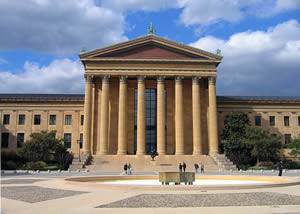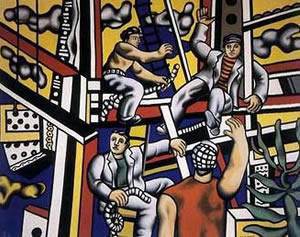
The Philadelphia Museum of Art
Philadelphia Museum of Art highlights modern Art of India in new exhibition
June 14 – December 7 – Philadelphia Museum of Art
]]>
In 1905, Britain had ruled the country for more than 50 years, and westernization had largely pushed indigenous artistic traditions aside. In response, many artists looked toward the past for new ideas inspired by a sense of independent nationhood. By the time the region obtained its freedom from Britain in 1947, new forms of urban contemporary art had forcefully emerged. Multiple Modernities: India, 1905-2005 (on view June 14 – Dec. 7, 2008 in the William P. Wood Gallery, 227) consists of more than 25 drawings, prints and watercolor paintings produced by South Asian artists before and after the region’s independence and subsequent partition into India and Pakistan. In addition to works from the Museum’s own broad collection of South Asian art, the exhibition includes a number of other works lent from the renowned Herwitz Collection of the Peabody Essex Museum in Salem, Massachusetts. Multiple Modernities was organized and made possible by a Halpern-Rogath Curatorial Seminar in the History of Art Department at the University of Pennsylvania.
The exhibition illustrates the range of artistic traditions and experiments in visual culture that emerged as South Asia transformed from a British colony to independent nation-states to a world economic power. Many of South Asia’s preeminent artists of the past century are represented, woven together by four themes.
The first sections, “Home and the World” and “Tradition and Invention,” look at the first half of the 20th century leading up to independence. They explore South Asian artists’ challenges to British rule and their attempts to establish a national identity through the visual arts. The debate on the nature of this identity included new appreciation of India’s varied artistic traditions. Jamini Roy (1887-1972), for example, looked toward regional eastern Indian folk traditions for his simplified forms and bold, flat colors. In The Festival (c. 1930-40), Roy used rich earth tones to evoke paintings by the local Santhal tribal group. The Festival , which comes from the Museum’s collection and is exhibited here for the first time, is an unusual work in the artist’s extensive oeuvre because of its large size and use of canvas rather than paper.
One of the most significant individuals in the fight for cultural regeneration was Rabindranath Tagore (1861-1941), who collaborated with a group of artists and intellectuals to launch what has been called the “Bengal Renaissance.” A writer, educator, and Asia’s first Nobel laureate (Literature, 1913), Tagore did not focus on visual art until he was well into his 60’s. The exhibition includes a rare and never-before-displayed group of seven of his imaginative and enigmatic drawings and paintings from the Museum’s collection. Some of Tagore’s works, such as Phoenix (c. 1928-30), depict bizarrely abstracted birds and animals that he described as un-liberated life forms struggling to escape the confinements of their bodies. A brooding oil painting of a woman’s head may be a portrait of Stella Kramrisch (1896-1993) — a teacher at Tagore’s experimental university in the 1920s and subsequently at the University of Calcutta and the University of Pennsylvania. Kramrisch was the Museum’s curator of Indian art from 1954 to 1993, and donated this group of Tagore’s works from her personal collection.
“From Artistic Collective to Individual Expression” explores the impact and aftermath of the Progressive Artists Group in Bombay. Formed in 1948 and disbanded a few years later, the group members searched for their individual artistic voices, rather than solely a national vision. Its members and associates included some of the major artists who shaped modern India, such as F.N. Souza, M.F. Hussain, and Tyeb Mehta, all represented in this exhibition. During the 1960s and 70s, a younger generation modeled in part on the Progressives renewed their search to infuse art with powerful individuality. Their variety of voices is evident in works including Bhupen Khakhar’s Shame (after 1983) and Gieve Patel’s Dead Politician (1972).
“Figuration and Abstraction” focuses on the latter half of the 20th century, and includes a recently acquired collage-lithograph by Atul Dodiya. Based on a minor episode in the great Hindu epic Ramayana, Sabari with her birds (2005) explores the power of faith through the tale of a tribal woman who spends her life alone in the forest preparing to encounter God. The work is part of a series inspired by three paintings by Indian artist Nandalal Bose (1882-1966), whose retrospective will be on display concurrently in the Museum.
“ Multiple Modernities offers an unusual opportunity to appreciate the breadth of South Asian art from the 20th century, and gives insights into the challenges that artists confronted in developing both a national identity and authentic personal voices,” Darielle Mason, the Stella Kramrisch Curator of Indian and Himalayan Art, said. “Many of these issues are also explored in our simultaneous special exhibition focused on the master painter Nandalal Bose, and to see both shows together at the Museum this summer is a rare treat.” Rhythms of India: The Art of Nandalal Bose (1882-1966) will be on view from June 27 to September 1, 2008.
Multiple Modernities was organized last fall by students in a Halpern-Rogath Curatorial Seminar at the University of Pennsylvania. Led by University of Pennsylvania Professors Michael W. Meister and Mason, graduate students Beth Citron, Nachiket Chanchani, Neil Ghosh, Jenna Levy, and Nyssa Liebermann selected the works for the exhibition, produced the wall and label texts, and traveled to Salem, Massachusetts to select works from the Herwitz Collection, the foremost public collection of 20th century South Asian art in the United States.
About the Collection of Indian and Himalayan Art
The Philadelphia Museum of Art houses one of the finest collections of South Asian art in the United States, including the spectacular Pillared Temple Hall (16th century) from Southern India; paintings and sculptures from India, Pakistan, Bangladesh, Sri Lanka, Afghanistan, Nepal, Tibet, and Bhutan; an important group of textiles; and a variety of decorative arts. Works from the Indian and Himalayan Art Collections are displayed in a series of galleries (224, 227, 229–232) on the second floor. The William P. Wood Gallery hosts changing collection exhibitions primarily devoted to 15th- through 20th-century painting from South Asia.
Follow us on:


